I was watching Sportstudio (Germany’s answer to Match of the Day) last weekend and Borussia Dortmund head coach Edin Terzic was the weekly guest. I thought he had an interesting take on management. He basically said everyone else — his bosses, the players, the fans, the media — judge and discuss the coaches with knowledge of the result. But the coach must always make the decisions without knowing the result.
Not 12 hours earlier I had watched Arsenal beat Nottingham Forest to kick off the new Premier League season and so much of the discussion was around the shape with Thomas Partey playing (or inverting from) right-back, whether it worked, whether Mikel Arteta had been overthinking and whether or not people wanted to see it ever again.
It feels important to remember Arteta picked the team he thought was best suited to win the game (they did), and that he didn’t know, not for sure, how it would work out with this setup. The questions for me are all about why Arteta made the changes he did, what he wanted to do with them.
Personally, I find the change an exciting one, mostly because we didn’t really ever change at all last season. Arsenal were predictable in 2022/23. We were good but we were predictable, playing more or less the same way and in the same shapes in every single game. If we want the team to take another step forward, that needs to change. And there can be no bigger change than deciding to leave out Gabriel Magalhaes.
And Thomas Partey really didn’t play right-back anyway, he played where he always does. At least he almost always did when we had the ball, and we had it 80% of the time. The change wasn’t that Partey played right back, it was that he played in midfield alone. That 3-2-5 shape in attack that existed, last season with Oleksandr Zinchenko tucking into midfield and previously with Granit Xhaka playing alongside Partey, has been a staple since Arteta arrived.
But not on Saturday. Partey tucked in and Arsenal were playing a 3-1 shape at the back, not 3-2. Or overall, a 3-1-3-3 or 3-1-6, not a 3-2-5. Partey was not at right-back and Rice was not playing in front of the backline.


 Now, why would Mikel Arteta do this? Ask the man himself and you never get a full explanation. Even the little he does give you isn’t very clear. Asked about Partey playing at right-back, the manager said:
Now, why would Mikel Arteta do this? Ask the man himself and you never get a full explanation. Even the little he does give you isn’t very clear. Asked about Partey playing at right-back, the manager said:
“We needed somebody else there in midfield to do what we have to do the best, and have more fluidity and occupy certain spaces in relation to how they were defending.”
But “somebody else” wasn’t in midfield. The fluidity, that’s certainly true, and the spaces related to Forest’s defending, well now we’re getting somewhere.
Forest play in what is probably best described as a 3-4-2-1, which is actually a pretty handy shape for pressing a regular 4-3-3 formation, with the central players forcing the ball wide and the back five swinging as a pendulum to allow the wingback on the same flank as the ball to push up and press the opposition fullback.
With Saka and Martinelli staying high to pin back the Forest wingbacks, playing with four men at the back to Forest’s three forwards was enough for Arsenal to play around any attempted press, and suddenly you have an extra player to stress their shape further upfield.
That allowed Arsenal to push Declan Rice forward to create a front six where there is usually a front five preventing Forest from going man-to-man at the back, or forcing their midfielders back to help out. At times, like below (with Nketiah out of shot in the left-wing position) Arsenal’s 3-1-6 (or 3-diamond-3 if you prefer, or 3-1-3-3, they’re all just numbers anyway and they can’t capture a fluid shape!) was pretty clear to see and Arteta’s side constantly had Forest outnumbered.
The offensive midfielders were preoccupied with the Arsenal backline (and wanted to offer a threat on the break) so usually weren’t close enough (or didn’t track back to help) when the ball went out to Gabriel Martinelli or Bukayo Saka. That left Forest with a few options, none of them good. They could allow the Arsenal winger to attack one-on-one, they could double up but with a wide centre-back, or (this one didn’t really happen) they could have a midfielder dragged out and leave his partner with acres to deal with. The wide centre-back option was the most common, but even that just meant one defender fewer in the box if and when Arsenal looked for a cross.
Immediately, Arsenal had more control than in almost any game last season. Turning that control into more shots, more opportunities, is the next step but, despite the nervy ending, we already saw an Arsenal side more likely to throttle and subdue the opposition than at any point last season. Arsenal recorded more touches (902) on Saturday than in any Premier League match in 2022/23.
And once the rotations become more ingrained — remember this was this team’s first time really playing like this, and with some players not completing a full pre-season plus the blow of the Jurrien Timber injury they seemed to tire in the second half — we should have more joy pulling defences apart to create openings.
There was an interesting increased amount of freedom for Bukayo Saka and Gabriel Martinelli in this ‘front six’ setup, with the pair roaming from the wings when the opportunity allowed. Martinelli almost latched onto a Ben White through ball in behind early on as Arsenal forces Forest so far back that we ended up with seven players across the front with no risks taken in case of a turnover:
More consistently, the wide centre-backs still offered offensive options. One worry of using Ben White at centre-back was taking away his relationship with Saka down the right and the excellent timing of his overlapping runs no longer being a weapon. We needn’t have worried.
Below is a great example of Kai Havertz’ positioning attracting both one of Forest’s wide forwards and one of their centre-backs to leave White wide open in what’s basically his usual right-back position.
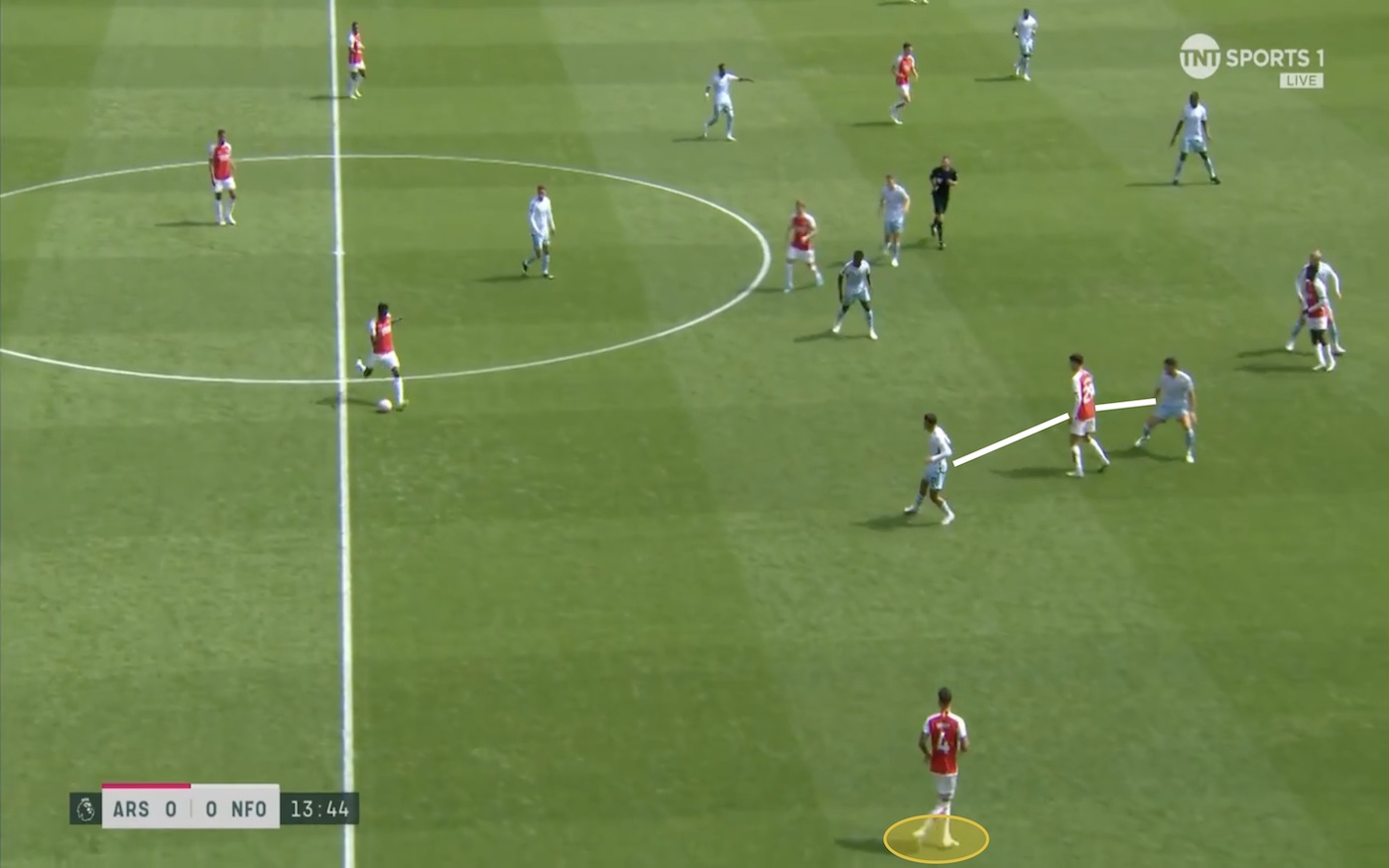 He formed part of that front six regularly, often with Rice not advancing as far forwards. That allowed Saka to move inside, just as Kai Havertz’ roaming out to the left allowed Gabriel Martinelli to do the same. Below, White and Havertz are our widest players, with Saka and Martinelli flanking Martin Odegaard as our most central player in the last line.
He formed part of that front six regularly, often with Rice not advancing as far forwards. That allowed Saka to move inside, just as Kai Havertz’ roaming out to the left allowed Gabriel Martinelli to do the same. Below, White and Havertz are our widest players, with Saka and Martinelli flanking Martin Odegaard as our most central player in the last line.
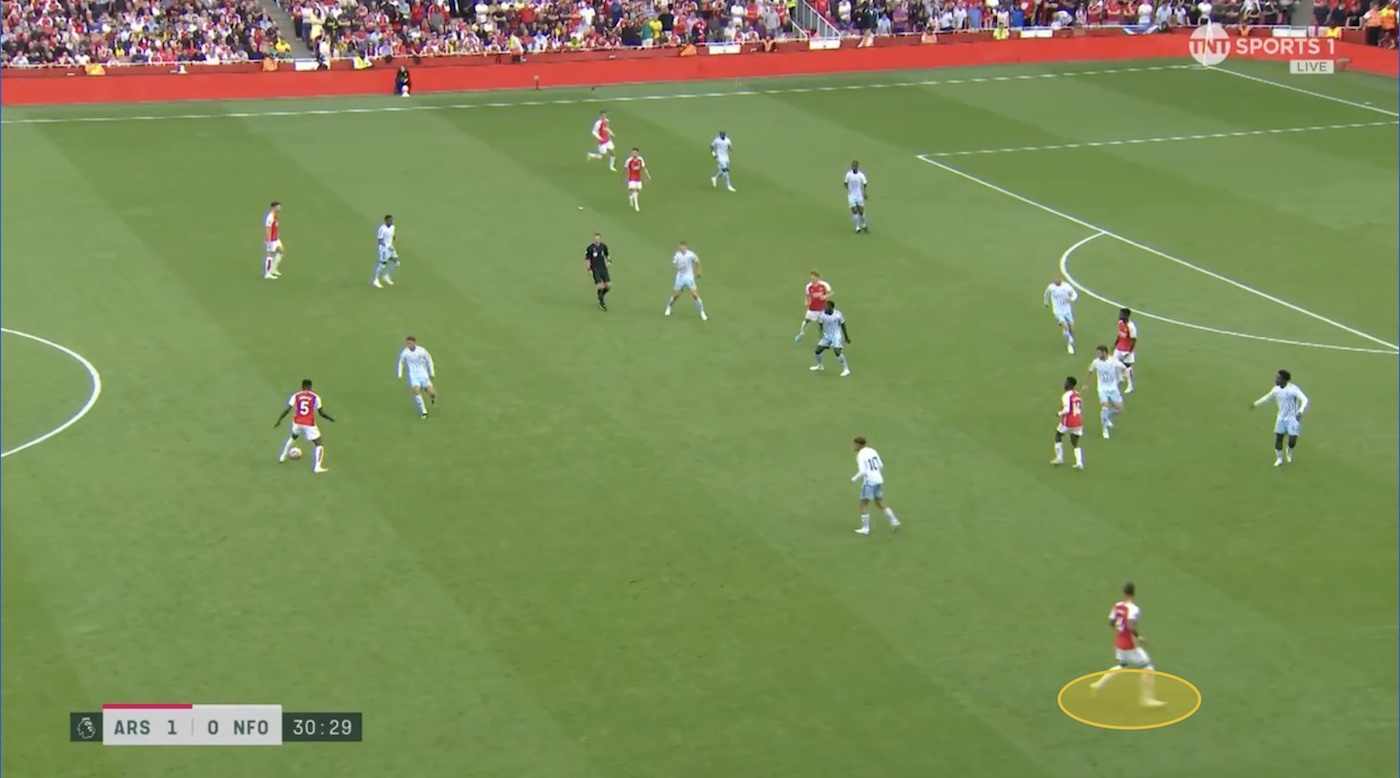 And when Saka did have himself doubled up on by Forest’s wide men, that familiar sight of a White overlap was there to help.
And when Saka did have himself doubled up on by Forest’s wide men, that familiar sight of a White overlap was there to help.
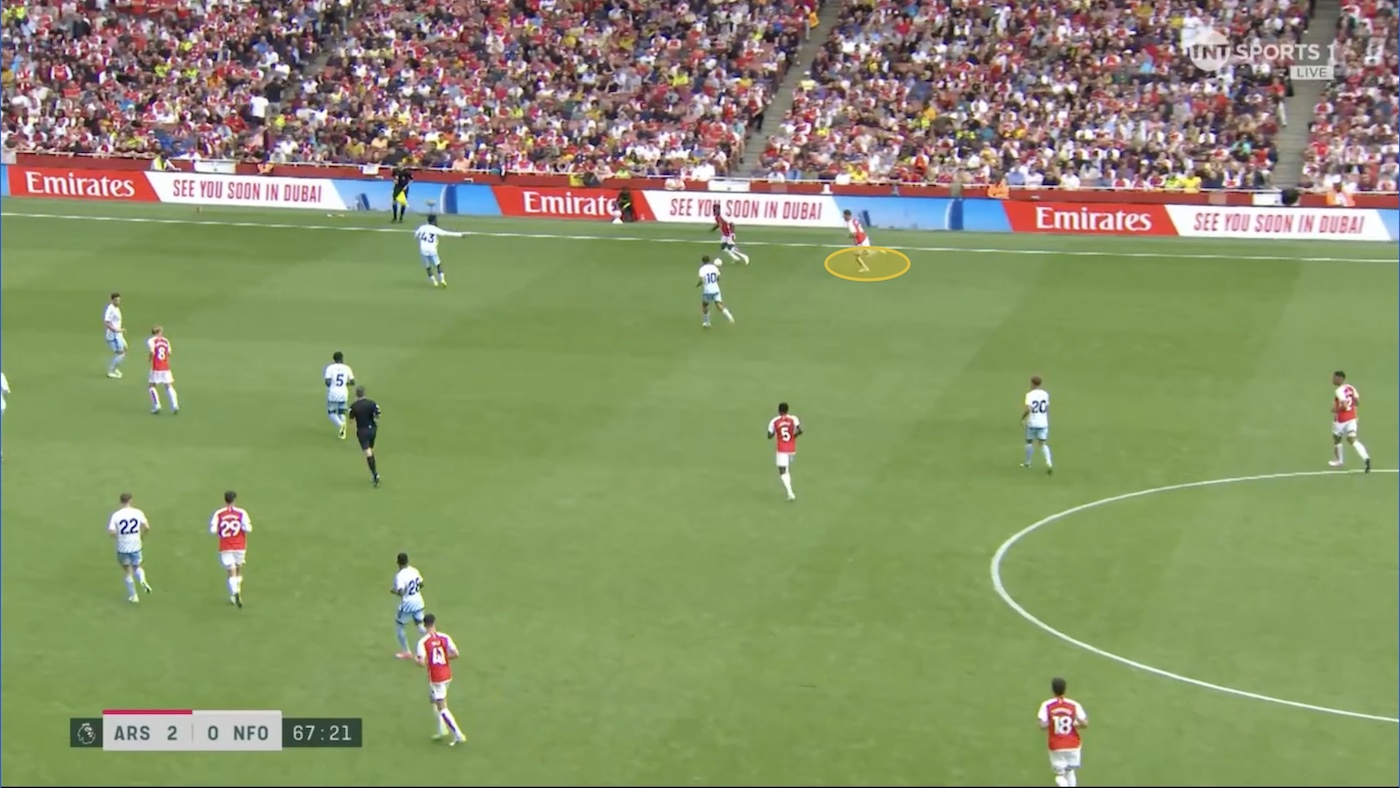 On the other side, Timber tended to tuck inside, swapping positions with Declan Rice. Here the back three is in tact but with Rice a part of it and Timber in midfield …
On the other side, Timber tended to tuck inside, swapping positions with Declan Rice. Here the back three is in tact but with Rice a part of it and Timber in midfield …
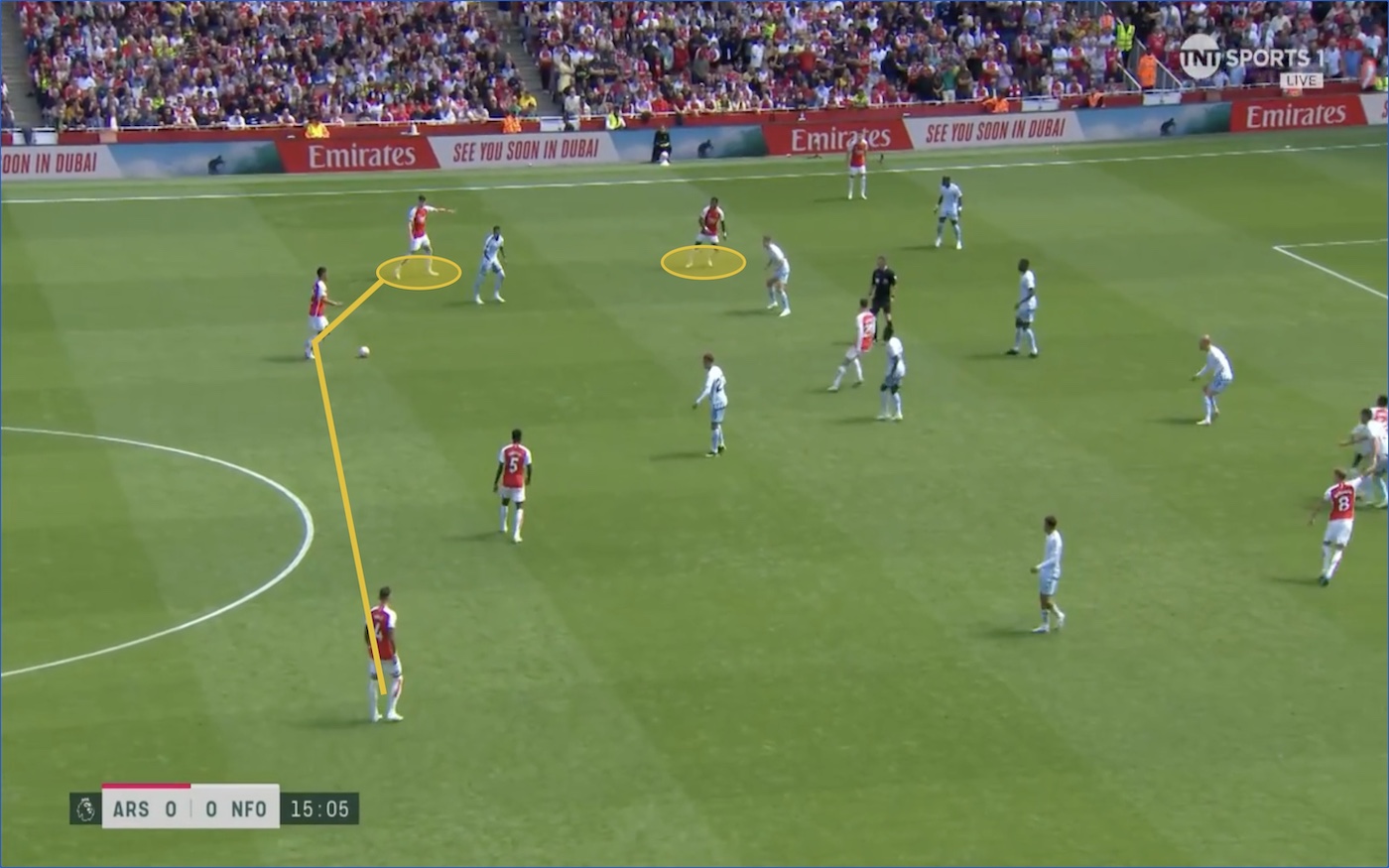 … when these opportunities arose, Rice was keen to encourage Timber to take up those midfield positions …
… when these opportunities arose, Rice was keen to encourage Timber to take up those midfield positions … 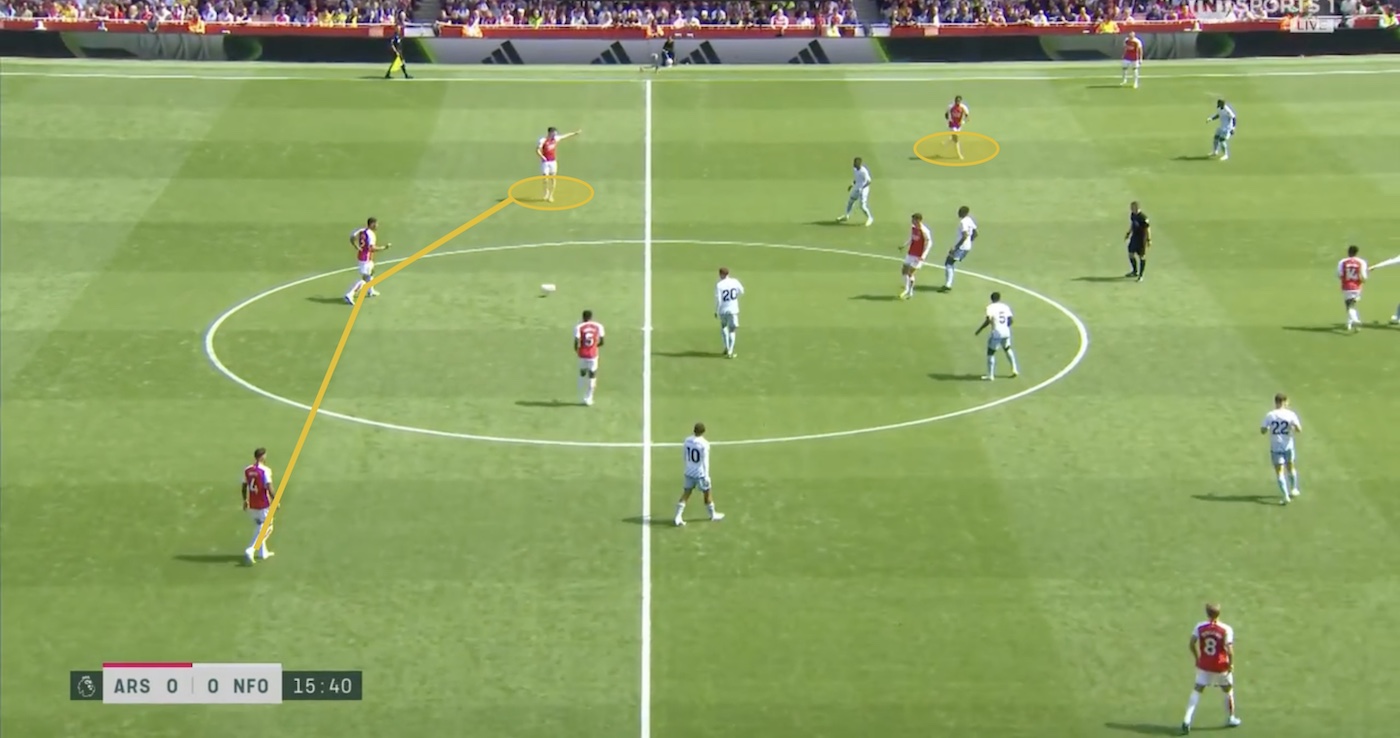 …and it’s actually with those players in those swapped positions that our second goal came about, with Timber feeding Martinelli, who was one-on-one so pulled the right-wingback out, allowing Havertz to dart in behind into the vacated space.
…and it’s actually with those players in those swapped positions that our second goal came about, with Timber feeding Martinelli, who was one-on-one so pulled the right-wingback out, allowing Havertz to dart in behind into the vacated space. The German’s cross was turned behind for the corner that led to Bukayo Saka’s goal to put Arsenal 2-0 up.
The German’s cross was turned behind for the corner that led to Bukayo Saka’s goal to put Arsenal 2-0 up.
Rice was keen to pull Forest players more centrally again after the break but Takehiro Tomiyasu was a bit more reluctant to push on as Timber had …
 … but not entirely unwilling.
… but not entirely unwilling.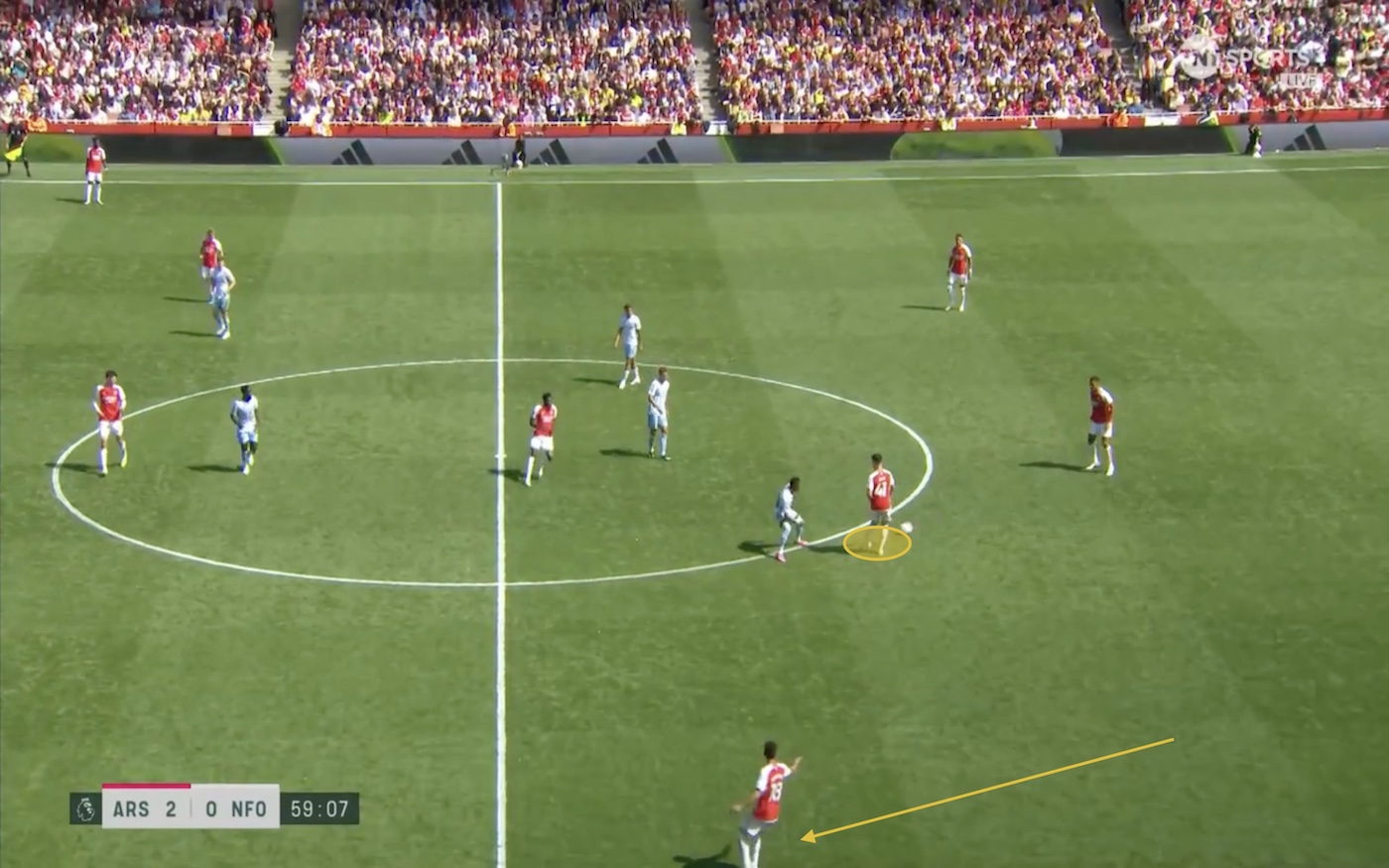 That wide centre-back role is an interesting one in this formation if we play such a defensive side again, with Arteta giving those players the freedom to rotate positions meaning you could be playing centre-back but end up on the wing or in midfield. It’s a role perfectly suited for Timber and his injury makes me think we will see the next iteration of this approach a little more tempered, if we see it again at all. Either way it’s a role that suits White perfectly and could suit Kieran Tierney, should he stay, perhaps even more than Tomiyasu, who isn’t too attack-minded at all, and Gabriel, who is not afraid of pushing up with the ball but is probably the least natural technician we have when you look at our defenders.
That wide centre-back role is an interesting one in this formation if we play such a defensive side again, with Arteta giving those players the freedom to rotate positions meaning you could be playing centre-back but end up on the wing or in midfield. It’s a role perfectly suited for Timber and his injury makes me think we will see the next iteration of this approach a little more tempered, if we see it again at all. Either way it’s a role that suits White perfectly and could suit Kieran Tierney, should he stay, perhaps even more than Tomiyasu, who isn’t too attack-minded at all, and Gabriel, who is not afraid of pushing up with the ball but is probably the least natural technician we have when you look at our defenders.
Overall, a lot to unpick from a 2-1 win against a poor side. And there’s plenty more, with Tim writing an excellent piece about Kai Havertz’ role and how he added to the fluidity.
I’m sure we’ll see something different against Crystal Palace but that — the idea of seeing something different every week — is no bad thing at all. This season should have plenty of tweaks for us to tuck into.
The performance against Forest was a dominant one in terms of possession and territory, but not scoreline and there needs to be more cutting edge the next time we roll out this approach. I’m sure Arteta and the team know that: remember, I’m talking after the fact, all these decisions were made before it. If we can tweak things and work out the kinks while still picking up all three points, that’s fine by me.






